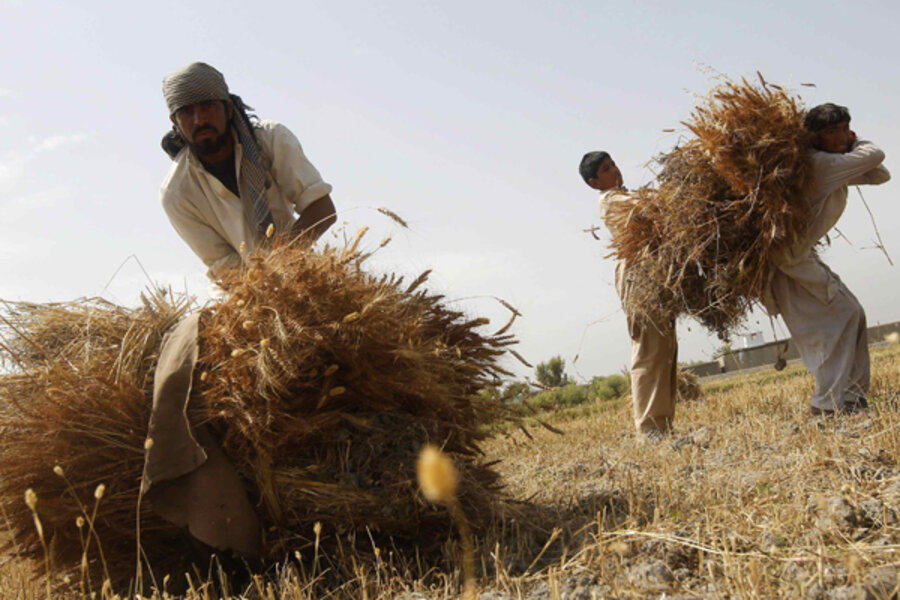Afghan insurgent attacks down: A sign of widening Taliban fractures?
Loading...
| Kabul, Afghanistan
Afghan and NATO leaders will gather in Chicago this weekend to discuss the future of security in Afghanistan as international troops prepare to end combat operations in 2014.
Throughout the past decade, international conferences about the Afghan conflict like this one have become a fixture on the international political landscape, though often producing opaque results.
Unlike past summits, however, the Chicago conference represents the first time such an event takes place amid a reduction in violence – a 43 percent drop of insurgent attacks, according to a report released last month by the Afghanistan NGO Safety Office.
ANSO called the drop in attacks the “first reliable indicator that the conflict may be entering a period of regression after years of sustained, and compounded, growth by all actors in the field.”
It remains unclear if this decline will stick. As the US pushes for a negotiated settlement to end the war, the Taliban has shown signs of increasing division. The ensuing fragmentation of the group could be behind the drop in violence, in which case the present calm remains extremely fragile.
The Afghanistan NGO Safety Office logged the 43 percent decrease in insurgent initiated attacks for the first quarter of 2012 as compared to the same period last year. The organization’s security reports are considered among some of the most reliable. Over the past year, they’ve been at odds with American and international military statistics that tracked a downturn in violence while ANSO recorded increases.
Still, many Afghan leaders are cautious.
“Fewer attacks don’t mean that the Taliban left the areas and that’s why their attacks have decreased,” says Ali Akbar Qasimi, a former Afghan Army general and a member of parliament from Ghazni province. He says that the Taliban and other insurgent groups remain active in many areas. Though members of the group may not be carrying out attacks, they often intimidate locals and impose their ultra-traditional views on rural communities.
The report also warns that a continued upsurge in criminality and the growth of irregular militias may present new problems for Afghanistan even if the downward trend of insurgent violence continues.
Widening fissures
The drop in attacks comes at a time when there appears to be widening fissures among the Taliban due to internal disagreements about whether to negotiate with the US.
Earlier this month, 25 prominent members of the Taliban were reportedly executed by the organization for talking to the US without authorization.
Additionally, a Taliban splinter group known as the Mullah Dadullah Front carried out the assassination of Maulvi Arsala Rahmani, a senior member of the Afghan High Peace Council, last Sunday allegedly outside the knowledge and control of the central Taliban organization.
“Maybe it’s because of the negotiation process that the Taliban is divided in parts,” says Naqeebullah, a former Afghan Army general who now serves as a member of parliament for Laghman Province. Like many Afghans he only uses one name. “This decrease in attacks might be because of the internal problems inside the Taliban. Whenever they have problems or disagreements inside, normally the attacks would get suspended for a short time or decrease.”
The distance between the Taliban foot soldiers fighting in Afghanistan and their leadership, believed to be mostly in Pakistan, has grown in recent years. Those fighting in Afghanistan sustain the vast majority of losses and have reportedly become embittered with the leadership hiding in Pakistan who is not exposed to the same level of danger.
The group's mid-level leadership has been particularly hard hit by Afghan and international operations. Last year, international forces conducted 2,200 night operations, which traditionally target the Taliban and insurgent group commanders. In 83 percent of those raids, soldiers managed to kill or capture their primary target or an associated insurgent.
'Not a monolithic movement'
“The Taliban itself is not a monolithic movement and there are so many local and regional powers. Some of them for their own reasons may have entered in tactical level talks, maybe to free some people or get a good deal for their own local forces,” says Jim Phillips, a senior research fellow at the Heritage Foundation. “They see a lot more risk in continuing the war; it’s a personal risk for them. They’re a lot more malleable and willing to engage, if only for local ceasefires.”
This willingness to broker deals at the local level could create room to reduce fighting. However, there are other Taliban fighters inside Afghanistan who have vowed to continue fighting even if their leadership brokers a peace deal with foreign fighters.
"We’ve wanted an Islamic government in Afghanistan and we will not stop fighting for this," says Salih Mohammad Akhund, a Taliban fighter in Helmand. "If the Taliban leadership puts any conditions on the negotiations with others, they should come first to us and ask us what we want and ask us if we accept the Afghan constitution or if we don’t accept some of its articles. Those who fight want Islamic law, and right now in Afghanistan there is not Islamic law."
Get daily or weekly updates from CSMonitor.com delivered to your inbox. Sign up today.







